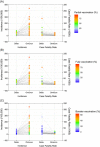Differences in incidence and fatality of COVID-19 by SARS-CoV-2 Omicron variant versus Delta variant in relation to vaccine coverage: A world-wide review
- PMID: 36056540
- PMCID: PMC9537802
- DOI: 10.1002/jmv.28118
Differences in incidence and fatality of COVID-19 by SARS-CoV-2 Omicron variant versus Delta variant in relation to vaccine coverage: A world-wide review
Abstract
We aim to evaluate the evolution differences in the incidence and case fatality rate (CFR) of severe acute respiratory syndrome coronavirus 2 (SARS-CoV-2) Delta and Omicron variants. The average incidence and CFRs were described between different countries. A gamma generalized linear mixed model (GLMM) was used to compare the CFRs of Delta and Omicron variants based on vaccination coverage. Totally, 50 countries were included for analyses. The incidence of coronavirus disease 2019 (COVID-19) ranged from 0.16/100,000 to 82.95/100,000 during the Delta period and 0.03/100,000 to 440.88/100,000 during the Omicron period. The median CFRs were 8.56 (interquartile range [IQR]: 4.76-18.39) during the Delta period and 3.04 (IQR: 1.87-7.48) during the Omicron period, respectively. A total of 47 out of 50 countries showed decreased CFRs of the Omicron variant with the rate ratio ranging from 0.02 (95% confidence interval [CI]: 0.01-0.03) (in Cambodia) to 0.97 (95% CI: 0.87-1.08) (in Ireland). Gamma GLMM analysis showed that the decreased CFR was largely a result of the decreased pathogenicity of Omicron besides the increased vaccination coverage. The Omicron variant shows a higher incidence but a lower CFR around the world as a whole, which is mainly a result of the decreased pathogenicity by SARS-CoV-2's mutation, while the vaccination against SARS-CoV-2 still acts as a valuable measure in preventing people from death.
Keywords: SARS-CoV-2 Delta; SARS-CoV-2 Omicron; case fatality rate.
© 2022 Wiley Periodicals LLC.
Conflict of interest statement
The authors declare no conflict of interest.
Figures





Comment in
-
Global case fatality rate from COVID-19 has decreased by 96.8% during 2.5 years of the pandemic.J Med Virol. 2023 Jan;95(1):e28231. doi: 10.1002/jmv.28231. Epub 2022 Oct 26. J Med Virol. 2023. PMID: 36253938 Free PMC article. No abstract available.
References
-
- WHO . WHO Coronavirus (COVID‐19) Dashboard. 2022. Accessed July 20, 2022. https://WHOCoronavirus(COVID-19)Dashboard
-
- Odusanya OO, Odugbemi BA, Odugbemi TO, Ajisegiri WS. COVID‐19: a review of the effectiveness of non‐pharmacological interventions. Niger Postgrad Med J. 2020;27(4):261‐267. - PubMed
Publication types
MeSH terms
Substances
Supplementary concepts
LinkOut - more resources
Full Text Sources
Medical
Miscellaneous

